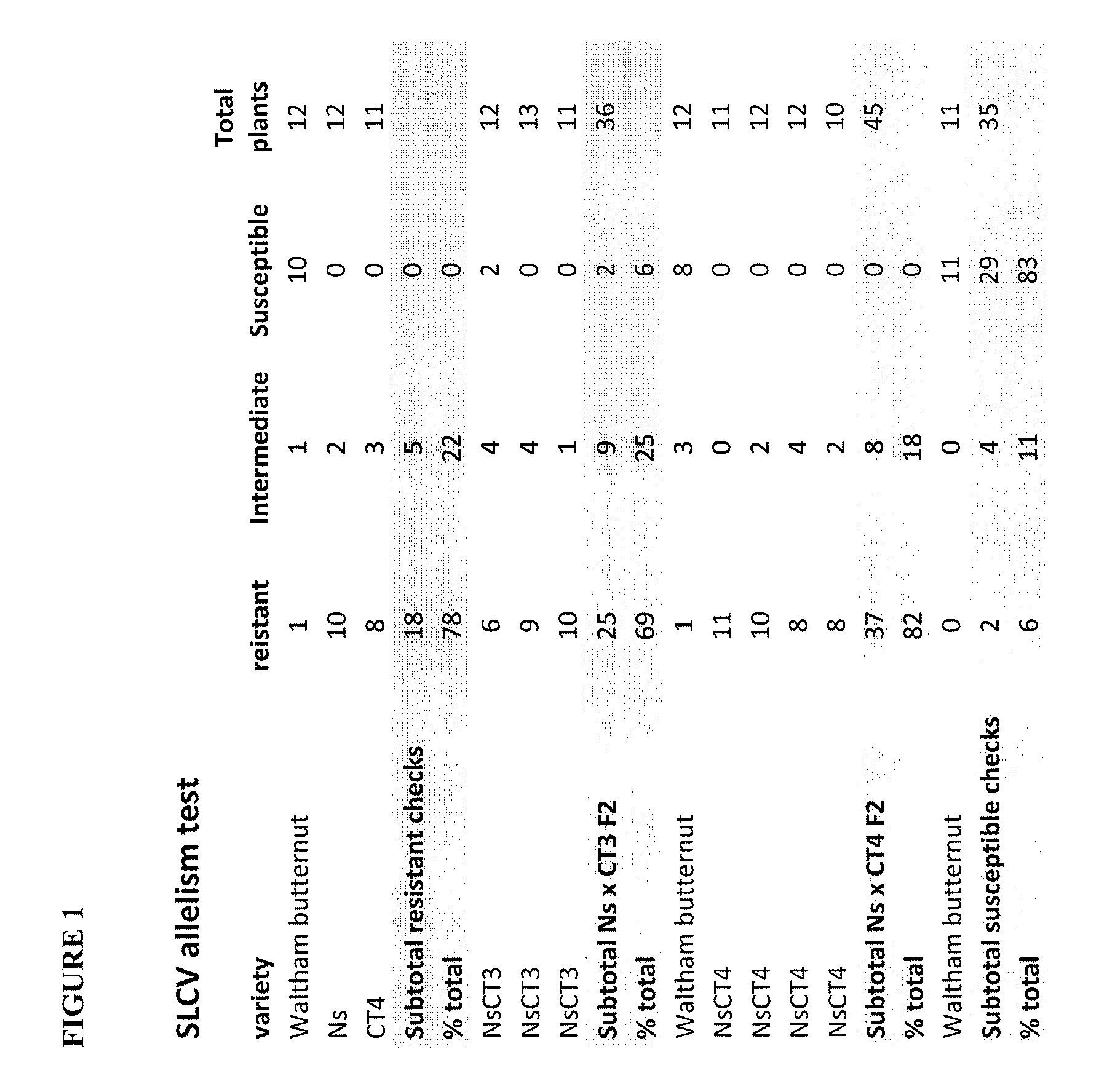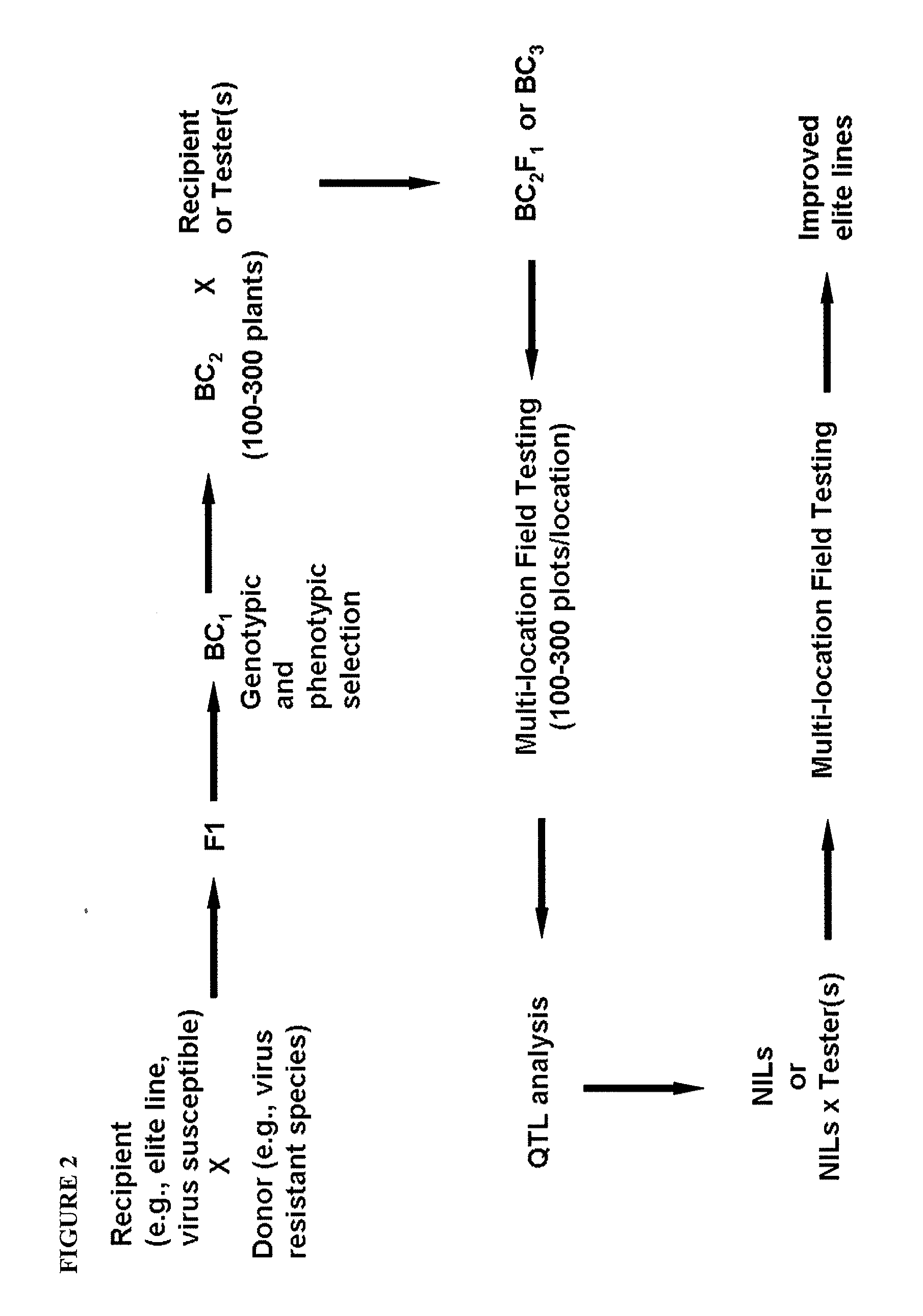Squash leaf curl virus (SLCV) resistance in cucurbits
- Summary
- Abstract
- Description
- Claims
- Application Information
AI Technical Summary
Benefits of technology
Problems solved by technology
Method used
Image
Examples
example 1
Identification of SLCV Resistant Starting Material
[0229]Several Cucurbita moschata lines were evaluated under different geographical areas in open field trials (natural infections conditions). Lines included ‘CT1’, ‘CT2’, ‘’CT3’, ‘CT4’, ‘CT5’, and ‘WSXP1030’(also as known as the ‘Ns’ line). ‘CT6’ was used as a susceptible C. moschata check or control line.
1.1 Evaluation of Different Tolerance Resistance Sources in Open Fields Trials, in Natural Infection Conditions
[0230]Locations and dates of planting were chosen because they were known to have a high probability of severe natural infection of SLCV.
Trial 1: Jordan Trial
[0231]The field in which the trial was conducted is near Amman, Jordan. Young plants were transplanted in the first week of a July. Two replicates of each lines to be evaluated were planted and each replicate had 10 plants. The evaluation was done on September 12 of the same year, using a scale from 0 to 5, wherein “0” is without any symptoms and “5” is very symptomat...
trial 5
son of ‘CT3’, ‘CT4’ and ‘WSXP1030’ to other squash cultivars ‘CT3’, ‘CT4 and ‘WSXP1030 were next tested in a trial against SLCV infection along with several commercial squash cultivars as check lines for comparison. The trial was conducted in Los Mochis, Mexico, using the same strategy as described above.
[0247]The test results in Table 5 clearly suggest that ‘CT3’, ‘CT4’ and ‘WSXP1030’ have far more resistance than the commercial cultivars against SLCV infection.
TABLE 5Open Field Trial - Comparison to Commercial CultivarsCODENo.Leaf CurlingCT310CT420WSXP103030Topazio42FES54CLUGO65Hurakan74Linda85Citlali92Leaf Curling Scale:0 = no symptom1 = small curling on old leaves2 = small curling and gauffrage on young leaves3 = small curling on young leaves4 = curling on young leaves5 = crispation and curling on young leaves
example 2
Allelism Tests
[0248]Three sources stood out for resistance to SLCV from the field test trials conducted under natural infection conditions as described in Example 1: ‘WSXP1030’, ‘CT3’ and ‘CT4’.
[0249]Allelism tests have been performed between these 3 lines to see if the same genes are involved in the resistance to SLCV. The test setup and results are shown in FIG. 1.
[0250]F2 populations were derived from the crosses of ‘Ns’בCT3’ and ‘Ns’בCT4’ were analyzed with resistant check lines (‘Ns’ and ‘CT4’ lines) and susceptible check line ‘Waltham Butternut’. The susceptible check, ‘Waltham Butternut’, had only 2 apparent escapes, and most plants had early and severe symptoms. The resistant checks, ‘Ns’ and ‘CT4’, did not have any susceptible plants, although there were some with intermediate symptoms (corresponding to 2 or 3 on the 0 to 5 scale). Without wishing to be bound by theory, the intermediate symptoms may due to some genetic variations, variations in seedling emergence or vigor...
PUM
 Login to View More
Login to View More Abstract
Description
Claims
Application Information
 Login to View More
Login to View More - R&D
- Intellectual Property
- Life Sciences
- Materials
- Tech Scout
- Unparalleled Data Quality
- Higher Quality Content
- 60% Fewer Hallucinations
Browse by: Latest US Patents, China's latest patents, Technical Efficacy Thesaurus, Application Domain, Technology Topic, Popular Technical Reports.
© 2025 PatSnap. All rights reserved.Legal|Privacy policy|Modern Slavery Act Transparency Statement|Sitemap|About US| Contact US: help@patsnap.com


